Additional Studies from the Poinsettia Trials
As a part of the additional studies from the 2015 North American Poinsettia Trials, we are presenting consumer survey results from trials at University of Florida (UF) (Table 1), North Carolina State University (NCSU) (Table 2) and Homewood Nursery and Garden Center in Raleigh, North Carolina, (Table 3) and an NCSU evaluation of cultivar resistance to Pythium root rot. For in-depth descriptions of the poinsettia varieties mentioned here, please refer to the article in the February 2016 issue of GPN or go to www.gpnmag.com.
CONSUMER PREFERENCE
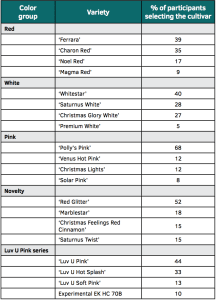
We all know that reds make up the majority of plants purchased with the red dominance being greater in mass market retail. A general observation is that poinsettia consumers tend to like most red cultivars, and for growers the decision on which red cultivars to produce is often more about the growth characteristics of the cultivar rather than about appearance. This year the top reds were ‘Titan Red’, ‘Premium Red’, ‘Novia’, ‘Christmas Beauty Red’, and ‘Christmas Glory Red’ at NCSU and ‘Novia’, ‘Mira’, ‘Red Elf’, ‘Matinee Bright Red’ and ‘Premium Red’ at Homewood. ‘Ferrara’ is a new vigorous cultivar that scored well in the direct comparison questions at UF and has good potential for growers on tight schedules and for big plants.
Consumers, however, show stronger feelings toward cultivars in the other color and novelty groups. This is one of the reasons that as we have seen in years past, again, the novelty cultivars tended to rank very high in survey results such as in the NCSU and Homewood surveys. For growers supplying differentiated markets, it becomes important to know which of the non-reds are favored by consumers and frequently must select cultivars on their appearance more than growth habit. Often, the better novelty varieties and colors can be more difficult to grow.
‘Ice Punch’ (a perennial favorite) ranked No. 1 and 10 at NCSU and Homewood, respectively. Additionally, in terms of total revenue generated, it is the leading cultivar in the student sale at the University of Florida. As much as ‘Ice Punch’ is a consumer favorite, many growers do not use it because of challenges producing high-quality plants. ‘Princettia Max White’ was the top-ranked cultivar at Homewood and a strong seller at UF. This new hybrid is a true white with many very small bracts and is considerably more vigorous than the rest of the Princettia series. Additionally, three novelties, ‘Sonora White Glitter’, ‘Carousel Dark Red’ and ‘Ruby Frost’, were highly ranked in both the Homewood and NCSU surveys. None of these would be considered routine in terms of production.
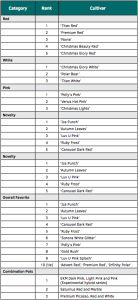
‘Autumn Leaves’ and ‘Gold Rush’ were ranked No. 2 and 8, respectively, at NCSU and both sold out rapidly in the UF sale. These are new cultivars that offer an opportunity to add diversity to the early poinsettia market.
We cannot cover consumer attraction for novelty poinsettias without talking about the hybrid, ‘Luv U Pink’, and the new cultivars in the series. They were not included in the Homewood survey, but at NCSU, ‘Luv U Pink’ was ranked No. 3 and ‘Luv U Pink Splash’ was No. 9. Also, in the UF direct comparison of four of the cultivars in the series, these two were the strongest cultivars. In the UF sale, this series made up 10 percent of the total 6.5-inch crop, and sold out rapidly at a premium price. ‘Luv U Pink’ is not a traditional look in poinsettias and some consumers and growers dislike them. However, the very strong attraction for some consumers is that the bright pink colors are just that — distinctly different.
Among traditional pink poinsettias, ‘Venus Hot Pink’ and ‘Christmas Lights’ are very nice new cultivars. But, the UF and NCSU results indicate there is still a stronger preference for ‘Polly’s Pink’. For traditional white cultivars, ‘Christmas Glory White’, ‘Polar Bear’ and ‘Titan White’ were the strongest at NCSU, and ‘Whitestar’ was the leading white at UF and Homewood.
NCSU PYTHIUM STUDY
Pythium root rot is a long-standing problem in poinsettia production. Emma Lookabaugh, graduate research assistant with the NC State Plant Disease and Insect Clinic, completed a second year of trials screening poinsettia cultivars for resistance to Pythium.
Symptoms of Pythium root rot include stunting, root necrosis, wilting, defoliation, poor vigor and, in extreme cases, death of the plant. For the 2016 season, 58 commercial poinsettia cultivars were evaluated for partial resistance to root rot caused by Pythium aphanidermatum.
Rooted cuttings were obtained from Dümmen Orange, Syngenta Flowers and Beekenkamp representing a variety of bract colors, response times and plant vigors. Cuttings were transplanted into 6-inch pots and inoculated with Pythium aphanidermatum three weeks after transplanting. Plants were evaluated for root rot and above-ground symptoms approximately three months after transplanting.
‘Cortez Burgundy’, ‘Neva’, ‘Mira Red’ and ‘Luv U Pink’, exhibited the fewest root rot symptoms. Root rot symptoms were highly correlated with above-ground symptoms, but some cultivars were able to withstand moderate/ high root rot symptoms with minor above-ground symptom expression. ‘Carousel Red’ and ‘Saturnus Red’ had the least above-ground symptoms with ratings equal to the non-inoculated controls. Root rot ratings and above-ground symptoms ratings were averaged to determine the highest performing cultivars overall. The top four cultivars were ‘Carousel Red’, ‘Mira Red’, ‘Luv U Pink’, and ‘Cortez Burgundy’. The lowest ranking cultivars included ‘Sparkling Punch’, ‘Red Glitter’ and ‘Advent Red’. These results were consistent with last year’s cultivar screening trial.
'Polly's Pink'
'Ferrara'
'Red Glitter'. Left is control plant and right is plant inoculated with Pythium three weeks after transplanting.
'Luv U Pink'. Left is control plant and right is plant inoculated with Pythium three weeks after transplanting.

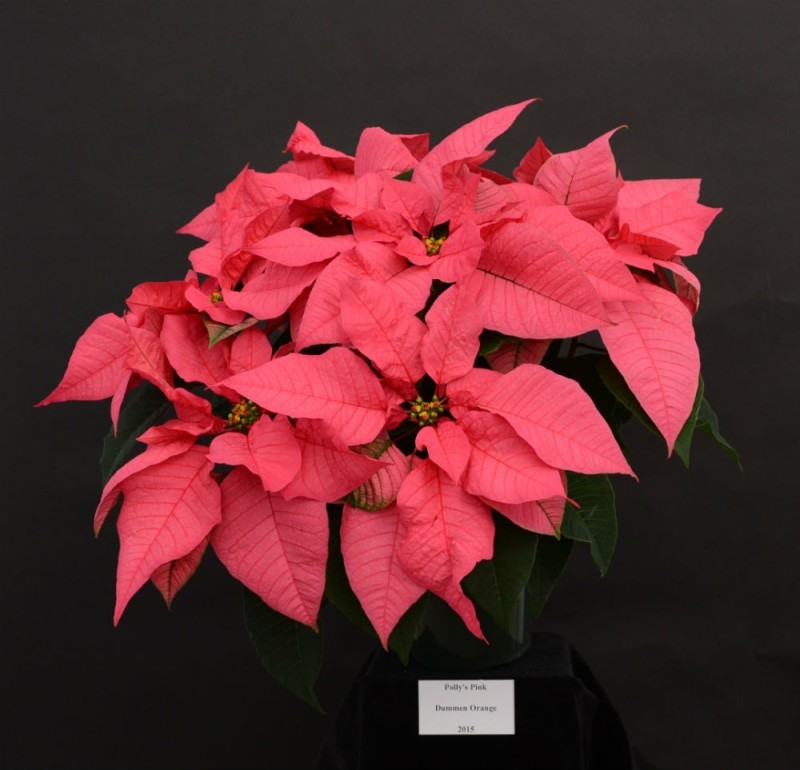

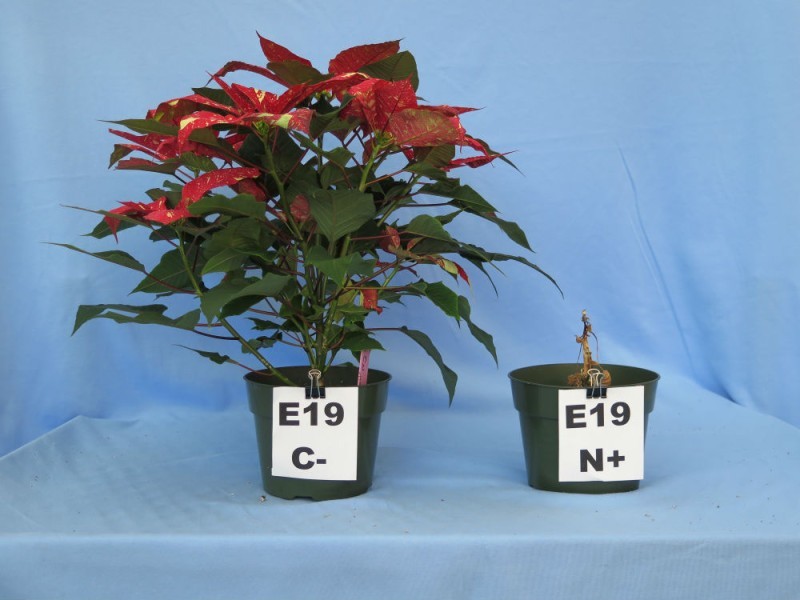
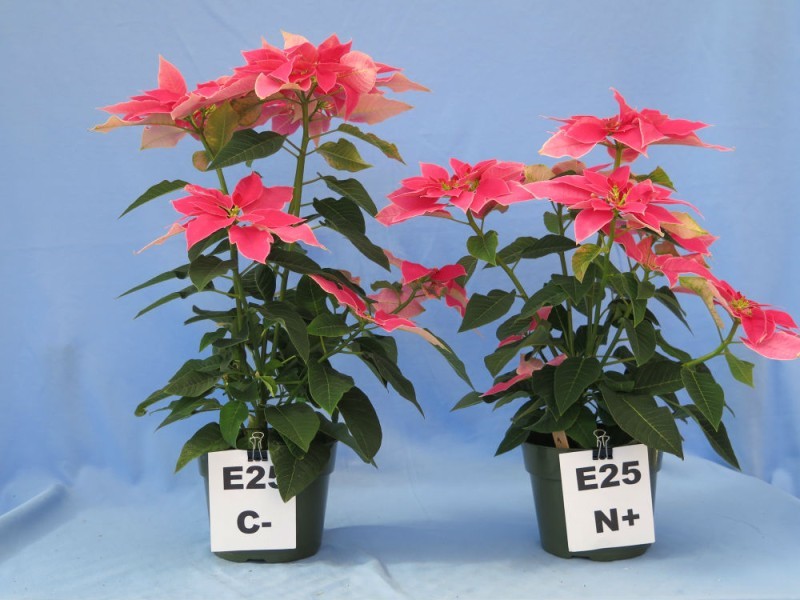

 Video Library
Video Library 




















